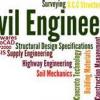Search the Community
Showing results for tags 'etabs'.
-
Hi all, I'm new here so I am not sure whether this question was already tackled on previous posts (pardon me). The thing is, I'm recently bothered by how I model my structure in etabs. My modelling practice is that I model the entire structure including the column pedestal (which is underground) and set the supports as hinged. Now I remembered that the base shear acts on the ground surface, how will I set the base shear to disregard the underground structure? Will I not have any mistakes when I run it for seismic analysis?
-
I'm designing a flat slab structure with perimeter cladding that is to be anchored to the edges of the slab. The external cladding has a total weight per meter run of 5 KN/m. How can I apply this load to the slab edges so as to model the true behavior of the slab under loading in order to get accurate results from the analysis?
-
Please clarify the following confusions one by one:- 1. If we run P-delta analysis in ETABS, then should we ignore stiffness property modifiers for beams and columns? I have heard that if we perform P-delta analysis and apply stiffness modifiers at the same time then the moment magnification process is doubled...? 2. ETABS considers selenderness of a column by applying moment magnification factors. If we run P-delta analysis also, does it mean that the selenderness of column is being over-estimated? I mean once the moments are magnified in P-delta analysis process and again through moment magnification process? Please help me understand the software myth and clarify above confusions.
-
Hi, i was searching the net for a little assistance with using the Etabs program. I'm very new to the program and have no formal education with it right now, the little i know is from watching a compilation of videos wherever i could find them, not as a complaint just painting the picture. I'm admittedly unfamiliar with a lot of things where the program is concerned and as such i've been having a hard time getting what i need done. My lecturers are leaning towards us utilizing the program as much as possible here as our manual design capabilities have already been tested in other forums. With this project we had a plot of land working with and we basically have the draft of what we want the building to look like the design process using the application just seems a mess to me. I have attached the file, any and all critique is welcome, i know it's a mess and i hope i with the experience i've seen shared through these forums i can have a better understanding of the program. Thanks in advance, any guidance would be much appreciated. Papine Market.$et
-
My Etabs 2015 Gives Very Little Reinforcement For The Columns Of My Rcc Building. What Might Be The Reason. My Etabs File Is Attached Herewith. https://www.dropbox.com/s/gy1ndwqau32dq64/house%20for%20rupendra%20bista%208.EDB?dl=0 house for rupendra bista 8.EDB
-
Dear all, Salam... I am designing one storey frame in seismic zone 4 (quetta) using ETABS v 9.7.2...building is a RCC bunker (105'X38') with adjacent office area (105'X50').. since RCC bunker has walls and slabs of thicknesses upto 4' and 8' thick... it becomes very stiff structure..how will frame structure for office adjacent to it will perform... guide me if I can take it as Non sway structure (office area) or not or I may design it by selecting SMRF option only in design preferences...kindly give me also literature/code reference for choosing SMRF/Nonsway criteria in zone 4 area of Pakistan....
-
CSI (ETABS, SAFE, SAP) SOFTWARES ANALYSIS FILES EXTENSIONS CSI (ETABS, SAFE, SAP) SOFTWARES ANALYSIS FILES EXTENSIONS After running the structural models they create numerous analysis files with very strange file extensions. Here I am talking about CSI softwares; ETABS, SAFE and SAP. These analysis files contain information about matrices and analysis results. More information about the file extensions can be found on CSI official webpage: https://wiki.csiberk...analysis models or https://wiki.csiberk... settings files When sending the model files to someone you dont need all those temporary analysis files rather just 2 files; one model file and another its text file. Why we need to delete the files? Well, one thing is there are lot of files which we dont recognize, and the major issue is they take too much of space. A single model may be upto 10MB or less or more, but after analysis, the folder size reaches sometimes upto 1GB, using hard disk resources. So its not wise to just leave them as is because once you have model file you can get the results on any machine after running it. For example for a simple model! An increase of about 62 times!Deleting the Files 1) From program To delete the analysis files of the model, there are many ways and techniques:- Open the model, goto File>Delete analysis files> There are 2 options; one for deleting analysis files of that model only and another to delete files of all the models in that specific directory. Here it can't delete the files of models in sub directories. Just imagine if you have a large project containing many buildings having at least 2 models, all in separate directories, so would have to open all of them one by one and delete files this way. 2) Manually Deleting the Files Another method is to search and delete the files yourself. Unfortunately, I could not find on internet a complete list of all the extensions of analysis files. So I just created sample files for each of the program and then converted by some means those extensions into a text file. I will for your convenience put all those extensions here. So just goto windows search explorer and just copy paste the extensions text string the file name box of search window and delete all the files in one go. If I have missed some extensions of mixed it with other programs, please correct me. 3) The best method While writing this article, I came across a very interesting method to do all that crap. There is file called Eat.bat in ETABS and SAP program files. When I opened these files in MS DOS, I found out that this DOS files deletes all the analysis files in that directory and you can get the list of all the extensions of the files if you try to edit it. Well that would be the official extension list of analysis files from CSI. The extensions I published below were extracted by me so they miss some extensions. I will later update those. This Eat.bat is found in ETABS and SAP folders but not in SAFE. I dont know why CSI people havent included this in SAFE. So I came up with an idea to modify the program so that it can do following:- 1) Delete all the analysis files, not just in that specific directory rather in all sub directories too and for all programs like ETABS, SAFE and SAP. I will just add all the extensions and a switch for deleting files inside other directories:- ERASE /S /Q * This program can be downloaded from here. Soon it will also be available in standard EXE format. Keep looking http://www.sepakistan.com/public/style_emoticons/#EMO_DIR#/tongue.png Extensions of CSI softwares:- 1) SAP *.MSH, *.MSH, *.K , *.K_?, *.K~?, *.Y??, *.$$?, *.C1, *.D1, *.F1, *.K1, *.M1, *.C3, *.D3, *.F3, *.K3, *.M3, *.T3, *.C4, *.D4, *.F4, *.K4, *.M4, *.T4, *.C5, *.D5, *.F5, *.K5, *.M5, *.T5, *.C6, *.D6, *.F6, *.K6, *.M6, *.T6, *.C8, *.D8, *.F8, *.K8, *.M8, *.T8, *.C9, *.D9, *.F9, *.K9, *.M9, *.C11, *.D11, *.F11, *.K11, *.M11 2) ETABS *.$$?, *.$$?, *.BRG, *.BXL, *.BXP, *.BXR, *.CSE, *.CSG, *.CSP, *.CSJ, *.F1 , *.F3 , *.F4 , *.F5 , *.F6 , *.F8 , *.F9 , *.F11, *.FUN, *.ID , *.IDS, *.JCJ, *.JCP, *.JCT, *.JOB, *.K , *.K_?, *.K1 , *.K3 , *.K4 , *.K5 , *.K6 , *.K8 , *.K9 , *.K11, *.KSB, *.L3 , *.LBK, *.LBL, *.LBM, *.LBN, *.LIN, *.M1 , *.M3 , *.M4 , *.M5 , *.M6 , *.M8 , *.M9 , *.M11, *.MAS, *.MSH, *.MTL, *.NPR, *.P1M, *.P1S, *.P3 , *.P4 , *.P5 , *.P6 , *.P61, *.P8 , *.P9 , *.PAT, *.PDE, *.PDU, *.PPD, *.R , *.RSI, *.RU , *.SCP, *.SEC, *.SEV, *.SHS, *.SPC, *.T3 , *.T4 , *.T5 , *.T6 , *.T8 , *.XMJ, *.XYZ, *.Y?? 3) SAFE *.$sf, *.$sf, *.C4, *.C9, *.D9, *.F9, *.fbk, *.ico, *.K~0, *.K~I, *.K~J, *.K~L, *.K~M, *.K9, *.M9, *.xsdm, *.Y, *.Y$$, *.Y~, *.Y~1, *.Y00, *.Y01, *.Y02, *.Y03 If you are using all of these programs, you will most probably like to search one time all of these extensions. So here I have merged them *.MSH, *.MSH, *.K , *.K_?, *.K~?, *.Y??, *.$$?, *.C1, *.D1, *.F1, *.K1, *.M1, *.C3, *.D3, *.F3, *.K3, *.M3, *.T3, *.C4, *.D4, *.F4, *.K4, *.M4, *.T4, *.C5, *.D5, *.F5, *.K5, *.M5, *.T5, *.C6, *.D6, *.F6, *.K6, *.M6, *.T6, *.C8, *.D8, *.F8, *.K8, *.M8, *.T8, *.C9, *.D9, *.F9, *.K9, *.M9, *.C11, *.D11, *.F11, *.K11, *.M11, *.$$?, *.$$?, *.BRG, *.BXL, *.BXP, *.BXR, *.CSE, *.CSG, *.CSP, *.CSJ, *.F1 , *.F3 , *.F4 , *.F5 , *.F6 , *.F8 , *.F9 , *.F11, *.FUN, *.ID , *.IDS, *.JCJ, *.JCP, *.JCT, *.JOB, *.K , *.K_?, *.K1 , *.K3 , *.K4 , *.K5 , *.K6 , *.K8 , *.K9 , *.K11, *.KSB, *.L3 , *.LBK, *.LBL, *.LBM, *.LBN, *.LIN, *.M1 , *.M3 , *.M4 , *.M5 , *.M6 , *.M8 , *.M9 , *.M11, *.MAS, *.MSH, *.MTL, *.NPR, *.P1M, *.P1S, *.P3 , *.P4 , *.P5 , *.P6 , *.P61, *.P8 , *.P9 , *.PAT, *.PDE, *.PDU, *.PPD, *.R , *.RSI, *.RU , *.SCP, *.SEC, *.SEV, *.SHS, *.SPC, *.T3 , *.T4 , *.T5 , *.T6 , *.T8 , *.XMJ, *.XYZ, *.Y??, $sf, $sf, C4, C9, D9, F9, fbk, ico, K~0, K~I, K~J, K~L, K~M, K9, M9, xsdm, Y, Y$$, Y~, Y~1, Y00, Y01, Y02, Y03 Rana Waseem ranawaseem.com
- 3 replies
-
- Deleting CSI Analysis Files
- Etabs
-
(and 2 more)
Tagged with:
-
Wind Tunnel Loading Data Wind Tunnel Loading Data Wind tunnel data is huge and tedious to input in ETABS or structural softwares. This data is produced from the wind engineering team’s softwares and usually provided in excel format. Usually if the building not regular, number of load cases are more than 20. How to import all that data into ETABS model is still a big issue because ETABS only lets you export the data to excel. There is no import facility from any database or excel sheet. Unlike SAFE and SAP, ETABS does not offer the facility to use interactive database editing. Well, I encountered this problem in my recent project, and then atlast I was able to import this bulk of numbers successfully in ETABS by using excel and VBA. Although I wrote the code for the format of data presented to me by the wind engineering team but it can be quite easily modified to satisfy other formats. Alternatively the wind tunnel data can be reformatted to match with the format, the coding accepts. If someone out of you has faced a similar problem and is unable to execute it, you can contact me personally. May be I upload the sheet soon here but for sure not now.
-
Here are a number of questions that I need answered. Help would be appreciated. Q1. In ETABS, what if the beam combined fail in Shear and Torsion? Need Solution Q2. In ETABS, Obtained moments on both ends on simple supported beams. What to do? Q3. Discuss dependance of foundation on bearing capacity of soil in SAFE model? What options do you have if the Bearing Capacity is very low? How would you check and find one way and two way shear in SAFE model? Q4. Why mass and weight are considered separate in ETABS? Q5. Differentiate b/w P-Delta analysis vs Dynamic Analysis? Q6. Material properties and strength of Concrete depend on what parameters? Q7. What limit "1" in punching shows in SAFE? Even if you know just one answer, please reply. It would be very helpful. Thank you and Regards.
-
hy this manual contains the fundamentals of Etabs 2013 http://www.4shared.com/office/Cjy51dfYba/6_story_rc_building_engaffoune.html
- 1 reply
-
- etabs 2013
- Etabs
-
(and 1 more)
Tagged with:
-
Salam everyone Eid Mubarak i have this kind of discontinuity in my etabs model when drawing ribbed slab, i tried many times and i couldn't get it right, i want to know if its going to affect my results knowing that i checked the model for warning and no warnings appeared.
- 2 replies
-
- slab discontinuity ETABS
- discontinuity
-
(and 1 more)
Tagged with:
-
I am looking for a complete reference for this data in etabs: Analysis Property Data: Design Property Data:
-
Material Property Data > Analysis Property Data Mass per unit Volume : 2.448E-06 Weight per unit Volume: 2.403E-03 I am looking for the source of this numbers.how can help me? I use etabs 9
-
How to: PARTIAL FIXITY in ETABS PARTIAL FIXITY IN ETABS Download article in PDF format Let’s take the case PARTIAL FIXITY in ETABS. There is no simple option to just release a specific percentage of moments and shear at the supports. The only way is to provide the reduced stiffness of the members. Let’s have a look at different options in ETABS for releases. You can access these options by clicking: ASSIGN>FRAME LINES>Frame Releases/Partial Fixity · There are many sets of combinations possible. You can get the details in ETABS help menu. For example it will not allow you to release torsion at both ends. · The various checkboxes you see in this form are for releasing (making 100% pin connection). One for start point of the section and the other for end point. Important point here is when you select the option either START or END the boxes for spring values will be enabled. By default the values in those boxes is zero which means the stiffness is reduced to ZERO so making it PIN connection. · To make partial frame releases (say only 50% of the moment), you need to put the“FRAME PARTIAL FIXITY SPRINGS” values in the START and END boxes. So, WHAT value I put for Fixity Springs 1- First you need to calculate the stiffness of the FULLY FIXED support and this calculated as k=4EI/L Where k = Fully fixed stiffness of the connection, E=Modulus of elasticity of the member, I=Moment of inertia in the direction of analysis, L=length of the member between supports. Here the important point is that L is the member length between supports in that particular direction (unsupported length). If the member is divided in let’ say 10 parts, you will not put the length of one part, rather the full unsupported length. 2-After calculating the actual stiffness value of the connection, you need to multiply it by the reduction factor by which you need to reduce the moment, shear etc. The reduction factor is:- REDUCTION FACTOR = n/(1-n) Where n is the percentage you want to reduce. For example if you want to reduce by 25% you will get REDUCTION FACTOR = 0.25/(1-0.25) = 0.33 You need to multiply 0.33 with 4EI/L to get the final spring stiffness value and put it in ETABS. There are following 2 cases involved:- I) Simple one frame analysis. Suppose I have a fixed end beam of 6m length. A load of 10kN/m is applied. The fixed end moments are wl²/12 = 30kN.m. E=2E+8 kPa, I=4.787E-3 m^4 Now I want to make the ends partially fixed/pinned, so that I get only 30% of the moment I’m getting now. (30% of 30kN.m is 9kN.m.). The REDUCTION FACTOR = 0.3/(1-0.3) = 0.43 Full fixity stiffness = 4EI/L = 638266.67 kN.m Reduced stiffness = 0.43 x 638266.67 = 274454.67 kN.m If I put this value in frame releases option in ONE END only, I will get 30% of 30kN.m moment that’s 9kN.m. Now the rest of the 21kN.m will be distributed in the beam and at the support on the other end. II) Second case, when we have a full 3D integrated structure. We may not get the moment values reduced by that percentage by which we applied the reduction factor, meaning to say we wanted 50% reduction in moment values but after analysis we got only 35%. So this process is iterative. You have to change the stiffness values based on many iterations unless you get the desired results. This is because the remaining moment should be redistributed to the other elements of the structure. Please see the picture below for the iteration process.
-
salam i have problem related to defining concrete material i have attached the image. its shown there that mass per unit volume of concrete is 2.24 and weight per unit volume of concrete is 8.68 while the units are kip-in. and fc'=4ksi. i want to know how both these value comes?? and if fc'=3ksi then what will be the values of these two?? i-e mass per unit volum nd weight per unit volume???
-
when we have raft foundation, is it necessary to draw it as we draw slab or just select all the joints at base level and turning them to fixed support will generate the effect of raft in analysis?
- 4 replies
-
- foundation
- raft
-
(and 2 more)
Tagged with:
-
Hello I have a simple wall model where one way slab is rested on walls. In plan walls are box shape. As slab is one way only two walls should carry the slab end reaction. Remaining two walls (parallel to one way dir) should not carry any reaction from slab. Could someone please help me how to model this. I did try but I'm getting reaction in all four walls. I enclosed the wall reaction image for your easy review. Thanks. ETABS.pdf
-
Assalam o alaikum I am attaching a model which I have made in etabs. This was the assignment which teacher gave us to design it. I have designed it in etabs this is my first model and need your guidence I want to know whether its acceptable or not??? If I need to revise it what things I should change.?? Also after designing we can see longitudinal steel, shear reinforcement etc.. this is different for each section so how I can use these to select the bar reqirement, spacing e.t.c as we have one section plan for beam and column etc. but this is different for all sections so how I select this for column, beam et.c what about slab?? Its reinforcement etc.. I used property modifiers and other tips also which I found on this site so kindly guide me. Details of the building r as follows. 4-story building X-direction spacing = 6 @10 feet Y-direction spacing =2 @20 feet One way slab Load is assigned using Shell/area loads ( I selected all panels of one story then applied the shell/area load dead, live et.c then for next story) but the load is not fully transferred to column etc, why? After analyzing the stress diagram looks odd to me. Rcc wall is used in basement. Auto meshing is done 4x4 Seismic effect is not taken into account so only one load combo is used. I deleted the others but after analysis they were shown why?? How I will know that any member is failing and I need to change it?? In final design we show the bar, spacing, etc but as I mentioned it is change for every sections so how I should finalize this for column beam and what for rcc wall?? After analysis it looks like that no load is transferred to it.. Kindly check this model by performing manual checks on it. Waiting for ur response. want to learn from ur experience thanks in advance assignment.rar
-
if we have to model a slab in etabs whose level is not same as surrounding slab i-e a drop slab let say 12" deeper slab then how to model such slab either model it at same level or we should add a reference plane and then draw it if we do so than we cannot apply diaphram to that slab so whats the best way to do this?
-
Hi I have uploaded a checklist for ETABS which i prepared a year ago! Thought to share! Will make it part of my next publication too! http://www.4shared.com/office/ITulouWj/Checklist_ETABS.html
- 3 replies
-
- etabs checklist
- etabs
-
(and 1 more)
Tagged with:
-
software are the tools that provide assistance to make things more accurate . i am using these softwares bt i am intrested to know what are the limitations of these?
-
how to draw a curved beam in etabs? i tried drawing a cylinderical grid and draw small lines then tried to join these lines but it does not work lines are joind. while the lines in horizontal or vertical can be joined .kindly suggest some way out?
-
Hi guyz! How would you design a concrete inclined wall? in ETABS we cannot assign piers to inclined walls..So the other way i think is to use moment contours...but how to design by moment contours? A wall has 2 out of plane bending moments, 2 out of plane shear components, 1 in plane shear and moment...so if i think to solve this in PCA column as a column then how to convert 2 out of plane bending moments and shears into 1 out of plane bending moment of column? Do I have to use Mmax and Mmin in ETABS or just M11 and M22...Please suggest!
-
i have a simple frame with single span 25' beam(12x18) supported by 2columns(12x12).loads on beam are 2k point load at the centre,500lb/ft uniform live load and 1000 lb/ft uniform dead load.columns are having same 1% reinforcement in both but beam shows 5.30% in Etabs and 1.52% in Sap2000.fc' for beam is 3000psi and for columns 4000psi.preferences are set to ACI318/IBC 2003. i couldn't upload the files ,on attaching "your are not permitted to upload this kind of file.










